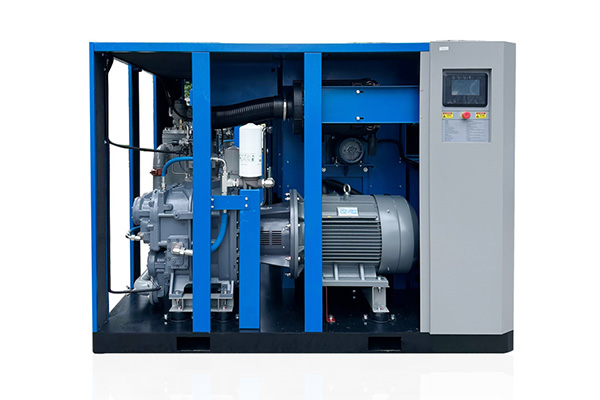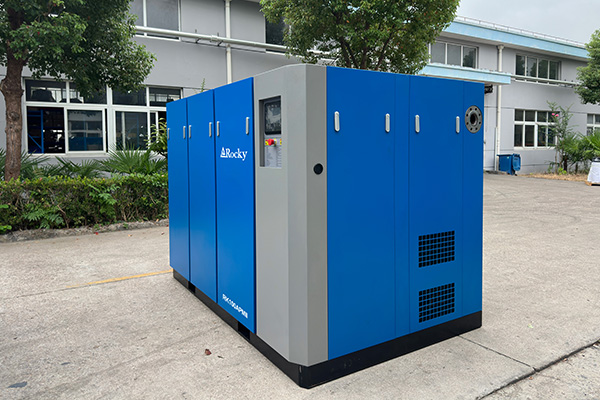Things to note when repairing screw air compressors
1. Explain the screw air compressor rotor maintenance method
During the overhaul of a screw air compressor, it is inevitable to find problems such as wear and corrosion of the rotor. Generally speaking, even if a twin-screw air compressor head is used for more than ten years (as long as it is used normally), the wear of the rotor is not obvious, which means that its rotor wear is not obvious. The efficiency drop will not be too great.
At this time, the rotor maintenance only requires a slight grinding of the rotor; collision and forceful disassembly should not occur during the disassembly and assembly process of the rotor, and the removed rotor should be placed horizontally and securely.
If the screw rotor has been severely worn, that is, the exhaust volume caused by leakage can no longer meet the user's gas requirements, it must be repaired. During repair, spraying and screw machine processing can be used.
However, since most service providers do not provide these services, it is difficult to complete. Of course, it can also be repaired by hand after spraying. This requires knowing the specific profile equation of the screw.
A module is processed for manual repair, and a set of special tooling is designed to complete the repair work.

2. What should you pay attention to before and after screw air compressor maintenance?
Before maintenance, the operation of the unit should be stopped, the exhaust valve should be closed, the power supply of the unit should be disconnected, and a warning sign should be hung. The pressure in the unit should be vented (each pressure gauge displays "0") before maintenance work can be started. When disassembling high-temperature components, wait until the temperature has cooled to ambient temperature.
Use the correct tools to repair the air compressor.
It is recommended to use special oil for screw air compressors. Different brands of lubricating oil are not allowed to be mixed after maintenance.
Original spare parts of the air compressor are specially designed and manufactured. It is recommended to use authentic spare parts to ensure the reliability and safety of the air compressor.
Do not make any changes or add any devices to the compressor that may affect safety and reliability without the permission of the manufacturer.
After maintenance and before starting, confirm that all safety devices have been reinstalled. After initial startup or electronic control system maintenance, before starting the compressor, you must first confirm whether the motor rotation direction is consistent with the specified rotation, and the tools have been removed from the compressor.

What does minor repair of a screw air compressor include?
There are only general distinctions between minor repairs, medium repairs and major repairs of air compressors, and there is no absolute boundary. Moreover, the specific conditions of each user unit are also different, so the divisions are different.
Generally, the content of minor repairs is to eliminate individual defects of the compressor and replace individual parts, including:
Check the carbon deposition on the rotor at the inlet.
Check the intake valve servo cylinder diaphragm.
Check and tighten the screws in various parts.
Clean the air filter.
Eliminate air compressor and pipeline leakage and oil leakage.
Clean the cooler and replace the faulty valve.
Check the safety valve and pressure gauge, etc.
What does the medium maintenance of screw air compressor include?
Intermediate repairs are generally performed every 3000 to 6000 hours. In addition to all minor repairs, mid-term maintenance also requires disassembly, repair and replacement of some parts, such as disassembling the oil and gas barrel, replacing the oil filter element, the oil and gas separator filter element, and checking the rotor wear.
Disassemble, inspect and adjust the thermal control valve (temperature control valve) and pressure maintenance valve (minimum pressure valve) to restore the machine to normal operation.
Briefly describe the reasons and necessity of periodic overhaul of the screw air compressor host
The air compressor main unit is the core part of the air compressor. It operates at high speed for a long time. Since the components and bearings have their corresponding service life, they must undergo preventive overhaul after running for a certain period of time or years. In summary, the main Overhaul work needs to be carried out for the following items:
Gap adjustment
The radial gap between the male and female rotors of the main engine increases. The direct consequence is that the leakage (ie back leakage) of the compressor increases during the compression process, and the volume of compressed air discharged from the machine becomes smaller. In terms of efficiency, the compression efficiency of the compressor is reduced.
The increase in the gap between the yin and yang rotors, the rear end cover and the bearing will mainly affect the sealing and compression efficiency of the compressor. It will also have a great impact on the service life of the yin and yang rotors. Adjust the rotor clearance during overhaul to avoid the rotor and the The case is scratched or scuffed.
Strong friction may occur between the screws of the main engine and between the screws and the main casing. The motor will be in an overloaded working state, which will seriously endanger the safe operation of the motor. If the electrical protection device of the air compressor unit is insensitive or fails, it may also cause the motor to burn out.
Host cleaning
The internal components of the air compressor host have been in a high-temperature and high-pressure environment for a long time. Coupled with the high-speed operation, there will be dust and impurities in the ambient air. After these small solid substances enter the machine, they will accumulate along with the lubricating oil carbon deposits over time. If it becomes a larger solid block, it may cause the host to jam.
Cost increase
Cost here refers to maintenance costs and electricity costs. Since the main engine of the air compressor has been running for a long time without overhaul, the wear of components increases, and some worn impurities remain in the main engine cavity, which will shorten the life of the lubricant. At the same time, due to impurities, the use of the oil-gas separator filter element and oil filter The time is greatly shortened, resulting in increased maintenance costs.
In terms of electricity costs, due to increased friction and reduced compression efficiency, electricity costs will inevitably increase. In addition, the decrease in air volume and compressed air quality caused by the air compressor host will also increase production costs.
To summarize: Normal host overhaul work is not only a basic requirement for equipment maintenance, but extended use may cause serious safety hazards. At the same time, it will bring serious direct and indirect economic losses to production.
Therefore, it is not only necessary but also necessary to overhaul the air compressor host on time and according to standards.

What does the overhaul of a screw air compressor include?
1. Overhaul the main engine and gearbox:
1) Replace the main engine rotor rolling bearing;
2) Replace the main engine rotor mechanical shaft seal and oil seal;
3) Replace the main engine rotor adjustment pad;
4) Replace the main engine rotor seal;
5) Adjust the precision clearance of gearbox gears;
6) Adjust the precision gap of the main engine rotor;
7) Replace the main and auxiliary rotating bearings of the gearbox;
8) Replace the mechanical shaft seal and oil seal of the gearbox;
9) Adjust the precision clearance of the gear box.
2. Add grease to the motor bearings.
3. Check or replace the coupling.
4. Clean and maintain the air cooler.
5. Clean and maintain the oil cooler.
6. Check or replace the check valve.
7. Check or replace the pressure relief valve.
8. Clean the water vapor separator.
9. Change the lubricating oil.
10. Clean each heat dissipation surface of the unit.
11. Check the working condition of each electrical component.
12. Check each protection function and its setting value.
13. Check or replace each pipeline.
14. Check the contact condition of each electrical component.